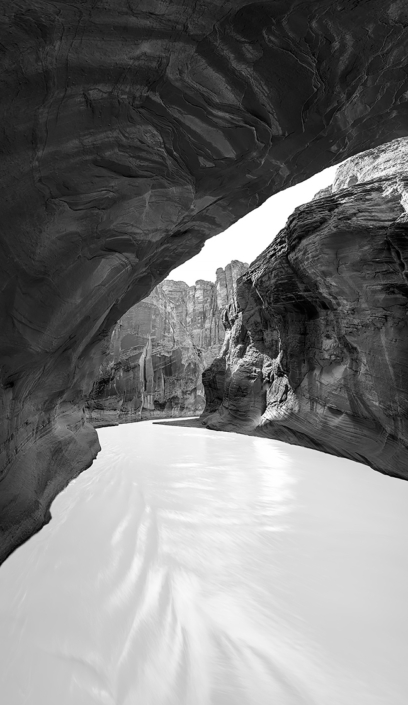In Erosion Stories of Paria Canyon, fine art photographer Jason Koster invites viewers into the awe inspiring theater of natural transformation deep within the Paria Canyon located at the Arizona-Utah border. The canyon is a 37-mile corridor carved by wind, river, and time. This portion of the series captured in 2024 during an arduous eight-day backpacking expedition through miles 7 to 27 of the canyon, marks the first phase of Koster’s ambitious project to document all 38 miles of the passage from Whitehouse Trailhead to Lee’s Ferry. 
The Paria River — its name originating from John Wesley Powell’s 19th-century translation of the Native American Ute Tribe word “Par-ria,” meaning “water muddy” — courses through the canyon with gentle determination. It is both the architect and life force of this remarkable landscape. In Koster’s vision, the flowing river becomes more than subject; it is rendered as a glowing white artery, the lifeblood of the landscape. Here, the river’s dynamism is a force of creation, erosion, and perpetual change. This is a stark contrast to his Land Speak of the John Muir Trail series where the still water of lakes of the Sierra Nevada Mountains were depicted as black symbolic mirrors of emotion.
Continuing the high-resolution, multi-frame stitching techniques first seen in his acclaimed Land Speak of the John Muir Trail and Giants in the Gulch series, Koster defies the traditional constraints of photographic framing. His limitless panoramic compositions continue to expand the edges of the scene either vertically or horizontally as needed, allowing him to once again look over a proposed scene and ask: where does my image begin, and where does it end? In Koster’s Land Speak of the John Muir Trail series is where we first see the technique of minimizing the sky and clouds. In Erosion Stories of Paria Canyon Koster takes that concept one step further by completely removing the time indicators of sky and clouds to help concentrate the viewers gaze upon the intricate interaction occurring before them as well as create a visual and symbolic relationship between the life-force of river and the time indicator of sky.
In this sparse and often inhospitable environment, where encounters with wildlife are rare and the pressing dangers of flash floods and isolation are real, Koster’s attention is drawn to the subtle, often overlooked relationships within the canyon walls. Whether rendered in vertical or horizontal formats, each image reveals a landscape engaged in its own silent dialogue, full of tension or grace, suggesting humanlike expressiveness.
 Erosion Stories of Paria Canyon is not a mere documentation of place; it is an evocation of process, of interaction and often overlooked exchanges. It reminds us that landscapes are not static backdrops but active participants in the shaping of history and land — a slow and ceaseless drama, unfolding beyond the immediate notice of those who pass through.
Erosion Stories of Paria Canyon is not a mere documentation of place; it is an evocation of process, of interaction and often overlooked exchanges. It reminds us that landscapes are not static backdrops but active participants in the shaping of history and land — a slow and ceaseless drama, unfolding beyond the immediate notice of those who pass through.
